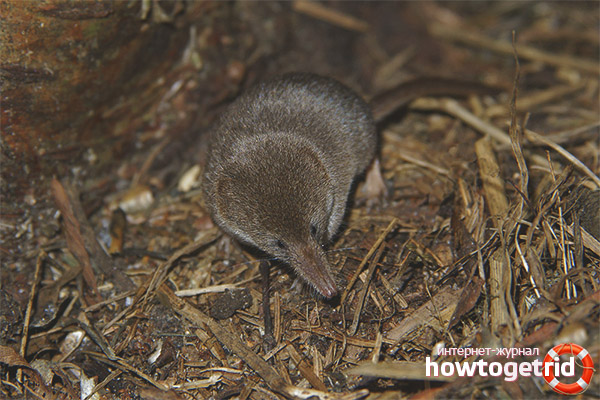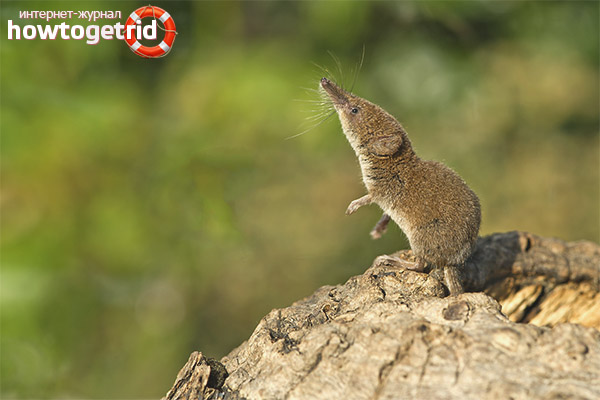The content of the article
Many people know about miniature hummingbirds, which are small birds, but not everyone has heard about mammals the size of a little finger, and such people also inhabit the planet. We are talking about shrews, which belong to the order of insectivorous rodents and are similar to mice with an elongated muzzle, but first things first.
Basic information
The family of shrews is the largest of all that relate to mammals. This factor is due to the special position of the shrews in particular and all similar vertebrates in general. Indeed, such small animals arose in the evolutionary process in order to utilize various insects and other invertebrates, which in turn are engaged in the disposal of animal remains and other decaying organics in ecosystems.
Here we will make a short remark and remind readers of the unity of ecosystems in which there are various varieties of living organisms and all perform some function that can conditionally be reduced to energy transfer. So, plants draw the energy of the sun and transform it, animals eat plants, and predators of other animals, and then they die and decompose. Then worms and insects enter the arena (there are other so-called ecosystem destroyers, for example, mushrooms), and then shrews, and other living organisms that eat ecosystem destroyers, appear. In general, there are a lot of worms and bugs in nature, and therefore such a food base allows their eaters, that is, insectivores, such as shrews, to actively develop.
There are about 700 species of shrews and they live all over the planet in addition to South America and Australia, but there are peculiar analogues of shrews - marsupials. For the most part they live underground, but, despite their own name, they do not dig land. For the most part, they use the burrows of moles and other animals, where they are engaged in the search for decaying remains, in other words, various corpses that they utilize with their own help.
The size may vary depending on the species, there are those that reach up to 10-12 centimeters, and there are representatives who weigh about one and a half grams. At the same time, the smallest shrews eat two to three times their own weight daily. The rule also applies: the larger the shrew, the more plant food it eats, because if the size of the species increases, then its representatives cannot feed themselves only on organic remains that feed on smaller animals.
Behavior features
These animals live in proud solitude, again because of hunger, which does not allow them to create any interest groups or trade unions to search for corpses and other organic remains. When you always want to eat, you only think about it and no one intends to share your own food supply. Therefore, a shrew, as a rule, occupies a space of about 70 meters in the substrate of the earth and daily makes a round to search for food. If an outsider (another shrew, mouse, lizard) appears on the territory, they enter into a battle, which often ends in the death of one of the participants.Further on the territory remains the one who defeated the opponent and uses this feed base.
In addition, shrews are quite a darling for larger animals. They are easier to harvest compared to mice and other rodents. Accordingly, shrews themselves form part of the food supply for predators of their territory.
A lot of behavior depends on seasonality and, although small animals do not make their minks, in regions where there is winter, and the number of insects in the cold period decreases, they can stock up provisions. In particular, shrew shrews live mainly in Russia. They store mainly coniferous nuts for the winter, which are reinforced by the lack of organic remains in the soil.
The most active in shrews is the autumn period, when you need to choose a site for wintering. Survival depends on this, and therefore in the fall, shrews often quarrel with other animals and rodents and try to get a better home for themselves in order to winter normally.
Reproduction and development

In general, the existence of a shrew is quite fleeting, it lasts only a year. Sometimes representatives of this species can live for two years, but only under the most favorable circumstances and a successful wintering. The approximate life cycle is as follows:
- Birth - in the summer and spring.
- Summer expanse, food storage.
- Autumn and the choice of dwelling for wintering, the Danelia effect (which we will talk about later).
- Spring leap in development, weight gain up to 50% and puberty, which is combined with subsequent reproduction.
- Pregnancy is about three weeks and a three-week maturation of the offspring.
Next, the cycle repeats. If someone manages to winter again, then they multiply and the next year. This does not always happen.
If you look at the very manner of reproduction and relationships, then shrews are quite immoral (in human terms) creatures. As soon as the spring leap in development ends, the males begin to search for the female and mate first with those who occupy neighboring sites. As a rule, several males mate with one female, and there are children from each in the litter.
After that, the males continue to move on, that is, they leave their sites in search of the female, and she appropriates this feed base. There are about 6-8 cubs in the litter, which the young mother tries to drive out as soon as possible so as not to occupy her forage base, but in practice, the cubs themselves often drive their mother away and occupy this territory. In general, as you see, the housing problem spoils not only Muscovites, but also shrews.
During the summer season, female shrews can make about three broods. Especially, if the female left (was kicked out) from her site by her cubs when she takes up a new site, then she again accepts the migrating males and the story repeats. And so on up to 3-4 times per season. Such activity is caused by a short duration of existence.
Interesting facts about shrews
These animals are unique in many respects and cannot be listed, but there is an opportunity to briefly talk about some.
- In fact, shrew is a name peculiar to the purely Russian language and culture, in other countries these animals are called simply, for example, they indicate a long nose or character. So, in English they are called the word “gateway”, which translates as obstinate and indicates the pugnacious nature of the shrew.
- In Africa, a unique species of shrew lives, which has a shock-absorbing spine. However, the spine has the ability to depreciate in almost all vertebrates - you say. Quite right, but not to the extent that the skeleton of the shrew dampens, because if you step on this animal, its ribs simply move, and nothing happens with the shrew.
- Individuals have an incredibly active metabolism, and at the same time they eat almost constantly (or are engaged in food search). This fact is caused by the need to maintain body temperature, because if large animals have thermal inertia (that is, if the body is heated, it then cools quite slowly), then small ones like a shrew can not use it, and they need to constantly receive energy that is converted in bodily heat.
- Shrews have a species gradation of their choice of diet. The smallest are predatory and prey on bugs, while the larger ones mainly switch to earthworms. The largest use mostly plant-based diet.
- August Danelia discovered the effect, which was later named after him. This effect is to reduce the body of shrews before winter. In order not to look for more food, they simply make less body and thereby solve the problem of winter food decline. Surprisingly, these animals reduce the amount of water in the body through a series of biochemical reactions. Thanks to this, even the size of the internal organs, skull and brain is reduced. By the way, this fact leads to some dullness of the shrews, which may even lose some instinctive reactions. Nevertheless, they needed brains in the summer during the search for food and minks, and in winter they only had to wait out the cold and survive until spring breeding. Therefore, shrews know firsthand how good it is to be stupid sometimes.
In conclusion, the sad fact about shrews, which is their genetic predisposition to die a year after birth. In the second year of their existence, they do not have winter molting, which is so necessary for colds, and, in addition, for the year they almost completely brush their teeth. Therefore, if shrews avoid all predators and dangers, look for the optimal food supply, then nature does not allow them to enjoy all this.
Video: shrew











Submit